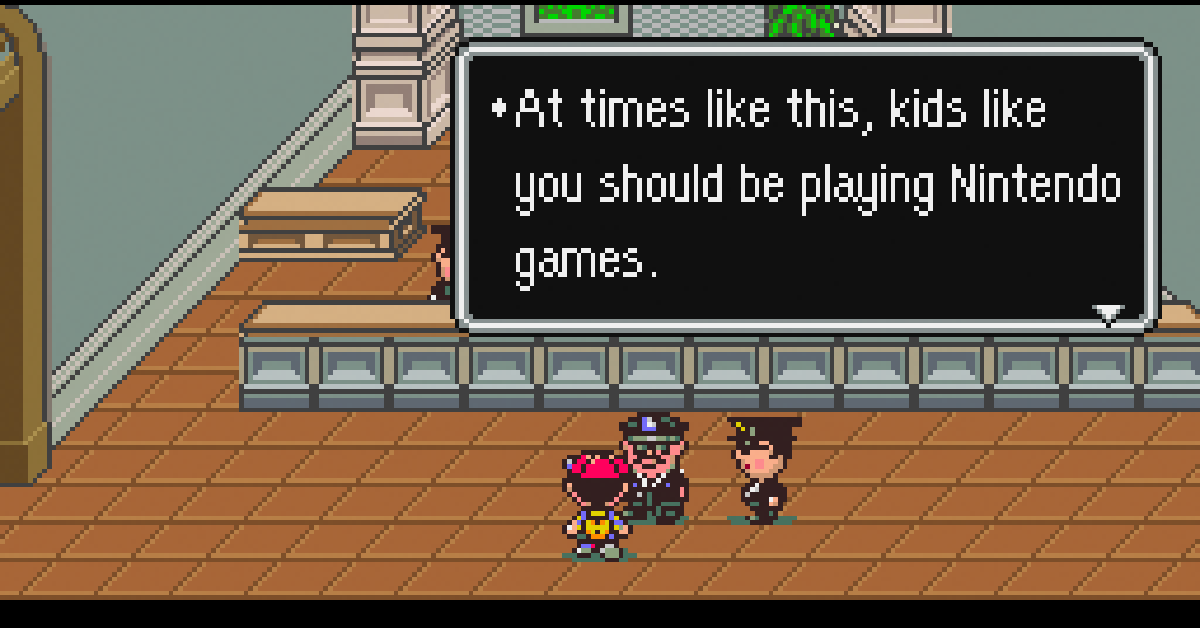
My Top 10 Video Games of “2018”
By Brian • 24 May 2019
With 2018 being my first full year as a father, the value of shorter games that I could play to completion in just a few hours became greater than ever. While binging a 5-10 hour game over a weekend is a perfectly cromulent option, I only have 45 minutes to an hour to play games, most days. That being said, I can drag a 5-10 hour game out for a week or two and perceive what most would consider a short game as a full, meaty experience. Naturally, you’re going to see a nice variety of these shorter games in this year’s top 10. They are the perfect length for my current lifestyle, seeing as I rarely finish a game thinking, “What? That’s it?”
However, I also filled a good portion of my 2018 gaming time with some lengthy roleplaying affairs. I have to approach games like this as a long-term commitment that might take six months or more, and to be prepared to take numerous breaks from them in order to enjoy a shorter experience along the way. A couple of these games captured enough of my imagination and attention to make the list, however.
This write-up took much longer to compile than usual—waiting five months later than usual to wrap it up and allowing my memories of these games to deteriorate didn’t help. So, what made the list in 2018? I better hurry up and tell you before I forget everything!
As always, the games on this list didn’t have to be released in 2018 (hence the quotation marks in the title), just that I either beat them or played the majority of them in 2018.
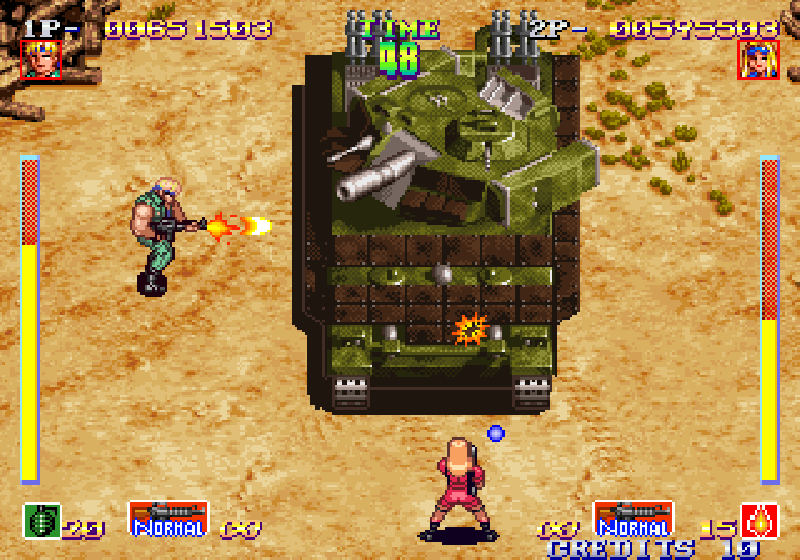
Honorable Mention: Shock Troopers (PC, 1997)
Shock Troopers has become one of mine and my brother’s go-to games to play online together, especially when we waste half an hour trying in vain to get other games to work, and then we’re in a rush to play anything before we both have to go to bed. Shock Troopers is quick, run and gun Neo-Geo arcade action with a lot of worthwhile features that set it apart from other military shooters from its era. You can choose from eight(!) playable characters, each with their own unique appearance and special attack, such as Southern Cross and his boomerang bombs, or Big Mama and her rocket launcher. Each character also has a unique vignette during the ending. There are three paths to take, each with its own levels and challenges. If enemies get too close to you, when you hit the fire button, your character will automatically pull out a knife and stab them, rather than shoot them, which I thought was a nice touch, if not a bit graphic. Usually they will drop a gem or something valuable when this happens, as well. Anyway, the music and presentation are great, the story is ludicrous, and it’s a good time. It’s exactly what a game should be.
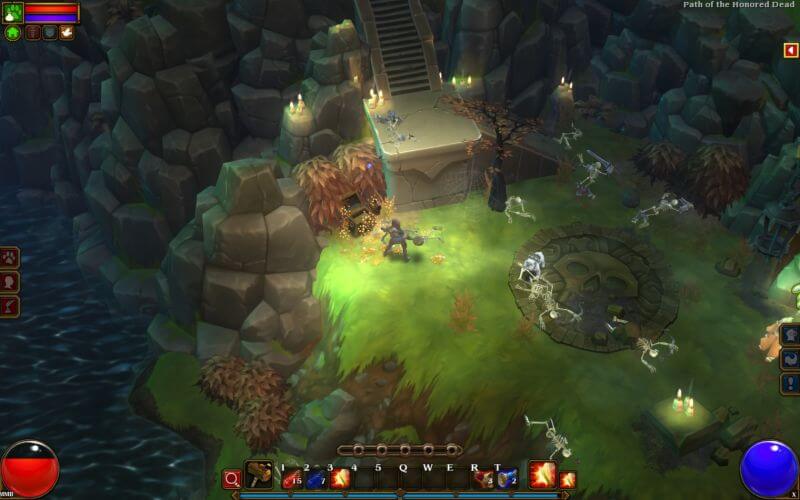
10. Torchlight 2 (PC, 2012)
Torchlight is the franchise that I play when I need more Diablo games faster than Blizzard can produce Diablo games (which is not very fast). I loved the original Torchlight, and the sequel was good, too. It added online play, which means I can play it online with Craig, and we did just that in 2018. There are lots of parallels between the first two Torchlights and the first two Diablos. For instance, in each franchise, the first game focuses on a single, deep dungeon under a town plagued by evil, while the sequel is a world-traveling adventure chasing down the gone-evil protagonist of the first game, with more character classes, a lot more wide-open spaces in outdoor settings, and numerous smaller dungeons to tackle along the way. These games are great fun, but I tend to get bogged down by inventory management and waste too much time comparing items that are too similar to one another, trying to decide which to equip. Hmm, use this sword that’s +1 to strength and 14-18 damage, or this sword that’s +2 to strength and 12-16 damage? Ugh. After a while, I stopped switching items unless a new one was significantly better than the old one. It took too much away from the focus of Torchlight 2: slaughtering evil. And believe me, there’s plenty of evil to go around, so get to slaughtering.

9. Double Dragon IV (PC, 2017)
I’ll admit it. When it comes to Bimmy Billy and Jimmy Lee waging war on underground martial arts organizations in a world that’s so post-apocalyptic that some of the Abobos have green skin, I just can’t get enough, and Double Dragon IV scratched my beat ’em up itch with the fury of a Spinning Dragon Kick.
This is kind of a weird installment in the series in that it borrows sprites from Double Dragons 1 and 2 on NES and throws them into newly designed locales. Many detractors criticized this design choice. As a whole, it’s true that the elements don’t exactly fit together seamlessly, but the game is so much fun that it doesn’t really matter. Plus, the classic sprites bring back a lot of fond memories of the NES games, which are far more interesting and playable than their arcade counterparts.
However, unlike the NES games, Double Dragon IV supports far more enemies on the screen at a time, which makes for some tough skirmishes. It was always a little disheartening to find myself on my back with five or six enemies surrounding me, waiting for me to get back up so they could beat me up some more! Luckily, the game offers some “recovery” super moves, like a jumping knee, that allow for some crowd control as I got back on my feet, so I was still never in a hopeless situation. Plus, more enemies means more punching bags!
I think my favorite part about Double Dragon IV is that it’s a “console beat-em-up” that limits your lives and continues. I like this because you can’t just feed the game quarters until you win. That’s fun, too, especially in the cooperative setting, but a console beat-em-up forces me to get better and try new things, getting progressively farther and farther into the game each time I play, until I finally do things right and finish it. It’s a slow burn to victory. That being said, I wasn’t fond of the fact that there is no option for online co-op, which means I can’t conveniently play it with Craig, but that’s my only gripe. Overall, it’s a great callback to the NES games, and offers a quick option to beat up a lot of jerks when I need to.

8. Oniken (PC, 2012)
Another retro-inspired game, Oniken is a sidescrolling action platformer in which Zaku and a band of resistance fighters battle against an overwhelming robot legion known as The Oniken. The gameplay feels a lot like Ninja Gaiden III or Kabuki Quantum Fighter, but the look of the game reminds of me of late-era NES games produced by KID or Natsume—stuff like G.I. Joe, Kickmaster, and Power Blade.
If this game was created to intentionally harken back to some of the NES’s most difficult challenges, it succeeds in a big way. The platforming and enemy placements make for a daunting experience, and each level includes a climactic moment that really put my skills to the test, such as being chased by a robotic polar bear while riding a speeder bike, or outrunning a fire rising below me through a vertical corridor, or a fight with a bunch of bounty hunters on top of a moving supply train. It’s 80s to the core, from its outrageous plot and characters to its level of difficulty. Fortunately, saving is allowed at the end of each level, so when I had to stop and go to bed or console a crying baby, I didn’t have to replay the entire game to get back to where I was, an ability I would have killed for (or maybe at least would have done a lot of household chores for) in the NES era.
Oniken is brief, but includes a number of additional challenges like hardcore mode and boss rush mode, so there is still plenty to see and do. It didn’t quite capture my attention the way another game from developer Joymasher did in 2018 (see #3), but I can still highly recommend it to the retro enthusiast.
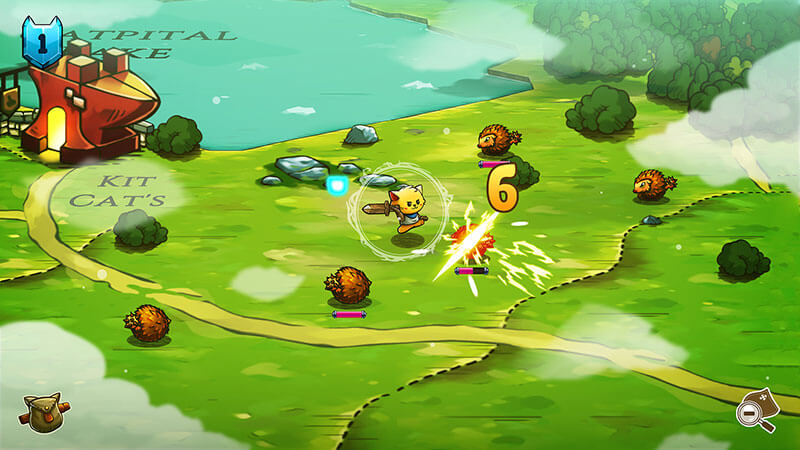
7. Cat Quest (Switch, 2017)
An action RPG featuring anthropomorphic cats up against dragons and a powerful cat wizard, tons of equipment and sidequests and secrets, and arguably more cat puns than every cat meme on the internet combined. CATS!
The character and enemy designs are cute and fun, the action is straightforward, and moving your character around and fighting on a literal world map, complete with location labels, boundary lines, and more, felt unique and added to the aesthetic in a big way. I’m already a geek for maps, so getting to play out an action RPG adventure on one was so enjoyable. The bite-sized quests allowed me to play for either 15 minutes or a couple of hours at a time and still have fun and make progress, which is a perfect fit for my lifestyle.
Not much else to say. If you like cats and action RPGs, it’s worth your time.
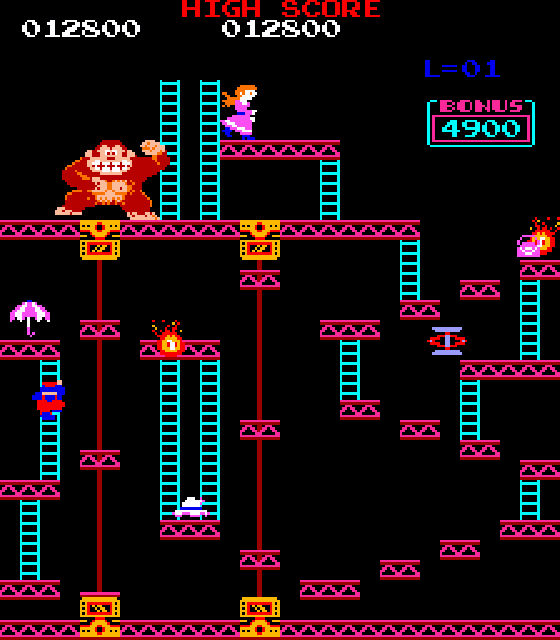
6. Arcade Archives: Donkey Kong (Switch, 1981)
Donkey Kong has to be my favorite arcade game of all time. It’s in a close running with Ms. Pac-Man, Robotron: 2084, Frogger, and many others in terms of fun, but I’ve put more hours of study, research, and strategy into Donkey Kong than any other arcade game, so it’s on another level altogether. When Broussard’s in Cape Girardeau was still in their old location, they had a Donkey Kong machine with a finicky joystick tucked away in one of their back rooms, and I was playing it a lot right around the same time the documentary, King of Kong, came out on DVD, which I foolishly went out and bought during an ice storm. My interest was further piqued by the film, and even though I’m not even a fraction as good as Billy Mitchell, Steve Wiebe, or any of the other masters who have come along in the wake of King of Kong, I still occasionally get obsessed with Donkey Kong and dump quarters into the nearest machine I can find.
The only problem has always been that a true arcade port of Donkey Kong has never been available on home consoles. Our Atari 2600 version we had growing up was highly compromised, and the NES version was missing the “pie factory” level. The Arcade Archives release on Switch was a dream come true. Finally, I can play authentic Donkey Kong from my own home, with all levels intact, without using an emulator. And yep, it’s still Donkey Kong, I still get buried by barrels and fried by fireballs each time I play, and I still love it. Playing the game with a Flip Grip makes for an even more authentic experience!
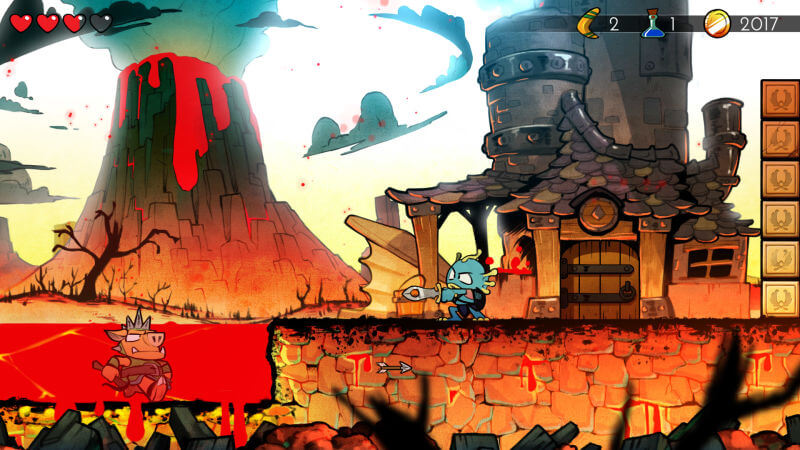
5. Wonder Boy: The Dragon’s Trap (Switch, 2017)
You may recall Wonder Boy in Monster World on Sega Genesis from my Top 10 Games of “2017” post. It was the first time I dove deep into a Wonder Boy game, and I came away with a thirst for more. Wonder Boy: The Dragon’s Trap is one of its predecessors from the Sega Master System, and was recently re-released with a tremendous visual overhaul. It’s still the original game, but with a fresh coat of hand-drawn art. You can hit a single button to switch between the original graphics and the updated graphics, but I don’t know why you would—the gorgeous hand-drawn visuals take the already attractive and fun Monster World aesthetic to a new level. I love the character and monster designs, and now they are even better.
Your character spends nearly the entirety of the game trapped in various animal forms, a curse put on him (or her—you can choose your gender at the outset) in the game’s prologue by a dragon adversary (hence “The Dragon’s Trap” moniker). Each animal form has its own pros and cons, and allows for exploration into certain areas. The bird form can fly, for instance, and therefore can explore in the sky. The mouse form can fit into cramped spaces. You get the gist. Later, an item is earned that allows you to switch between animal forms, at will, and that’s when the game really opens up. The game world is the perfect scope. It’s not too compact, but not too sprawling, either. It was another 5-10 hour romp that fit well into my schedule, and I was able to finish it without it feeling too long and before I could lose interest.
The Dragon’s Trap is not too tough, either. During boss fights, I didn’t even have to bother with pattern recognition; I was always able to just wail on them faster than they could wail on me, which was a little disappointing. Much of the rest of the game world provided sufficient platforming and combat challenges, however. There are some pretty obtuse secrets, as well, including several spots where you simply push up in the right spot to find a hidden door, with minimal clues pointing you in the right direction. But, being just a re-skin of the original, this is to be expected. All that being said, the positives far outweigh the negatives, and my great experience with The Dragon’s Trap surely means more Wonder Boy games in my future.
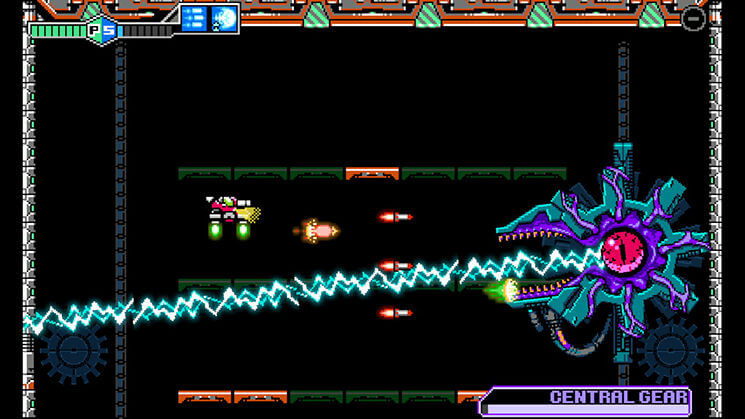
4. Blaster Master Zero (Switch, 2017)
Among all my favorite NES games, the original Blaster Master is the only one I have never been able to finish without rampant cheating. It is a great game, full of bizarre locations and enemies, catchy music, and cool technology like a tank that drives on walls and jumps. It jumps! It’s too bad the difficulty level is utterly unforgiving, to the point of controller-throwing, sofa-smashing, and really poor attempts at creative swearing.
Fortunately, a remake from developer Inti Creates rights many of the original’s wrongs, and while it doesn’t quite recapture the quality of music and some of the imagination of its NES counterpart, it’s still the superior game, and came as a welcome change from the no-holds-barred original.
Never heard of Blaster Master? I’ll summarize: teenage boy’s pet frog turns radioactive and runs away, so teenage boy hops in a giant future tank he finds in his backyard and mows through an underworld of freakish enemies to rescue his frog and, oh yeah, save the world along the way. A fairly relatable concept, don’t you think? Happens to me all the time. There are also areas that Jason, the teenage boy, must explore on foot, and these areas are almost always far more dangerous than the tank sequences, resulting in a cool juxtaposition between your power with the tank, and your vulnerability without.
Like I said earlier, the music is not quite as good as the original, and some of the settings are a bit less imaginative (the crazy underground castle in Area 2, for instance, is now a boring residential area), but otherwise, I think the remake is an improvement in every way. There are more weapons, including some with helpful secondary uses (the flamethrower melts slippery ice) that keeps the adventure interesting and encourages experimentation. It looks fantastic, recaptures the adventurous spirit of the original, is just the right length, and is far more forgiving. It even canonizes some elements from the extremely corny novelization of Blaster Master by F.X. Nine, which is super dumb, but super fun. There are even multiple endings, and let me tell you, you’ll know if you get the bad one.
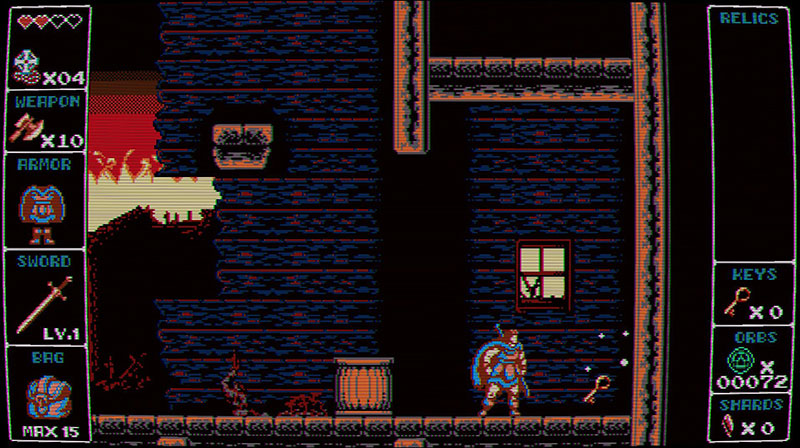
3. Odallus: The Dark Call (PC, 2015)
I don’t know about anybody else, but any time I see “Odallus,” I think of former Los Angeles Dodgers pitcher, Odalis Pérez.
I’ve seen Odallus compared to Castlevania on a number of occasions. In fact, developer Joymasher even lists Castlevania among its influences in the creation of Odallus. And aesthetically, that’s true. If NES-era Tecmo or Natsume made Castlevania, it would probably look something like this. And yes, there are subweapons and the occasional wall meat and a “vampire killer” alternate outfit for the hero, so the homages are there, as well. But, other than maybe Super Castlevania IV, that’s where the comparison ended for me. Gameplay-wise, Odallus seemed much faster and more fluid than Castlevania. It apparently plays much like Demon’s Crest on Super Nintendo, which I haven’t played (yet), so I’ll take everybody’s word for it.
In any case, Odallus is an immersive, but dark and brooding experience that I had a lot of trouble putting down once I got started. The setting is gothic and macabre, where everything is dying or undead, in ruins, and all of the statues look like half-decomposed corpse versions of great heroes. Some areas even seem to pulse with living evil. The music is equally foreboding, and playing this game gave me a true sense of despair. Not enough to make me quit playing, though–just enough to make me feel protagonist Haggis’s pain and want to avenge his burned village and rescue his son from an army of demons.
This is one of those action games in which running in without a plan is a death sentence. It encourages patience and strategic thinking. There is also some light puzzle-solving, and each level is big and has many nooks and crannies to explore and hidden upgrades to unearth, but both of these features are well balanced with the action. You can also return to levels you’ve already explored to fish out any secrets you may have missed, and the map screen between levels tells you how many secrets you’ve found in each one (and how many are remaining), which makes backtracking and exploration far less tedious.
Again, Odallus was the perfect length–about five or six hours. This appears to really be the target completion time for me, these days. I can make a game that length last a good 10-14 days, which is long enough to be engrossing, yet short enough that it never feels like the game is starting to drag.
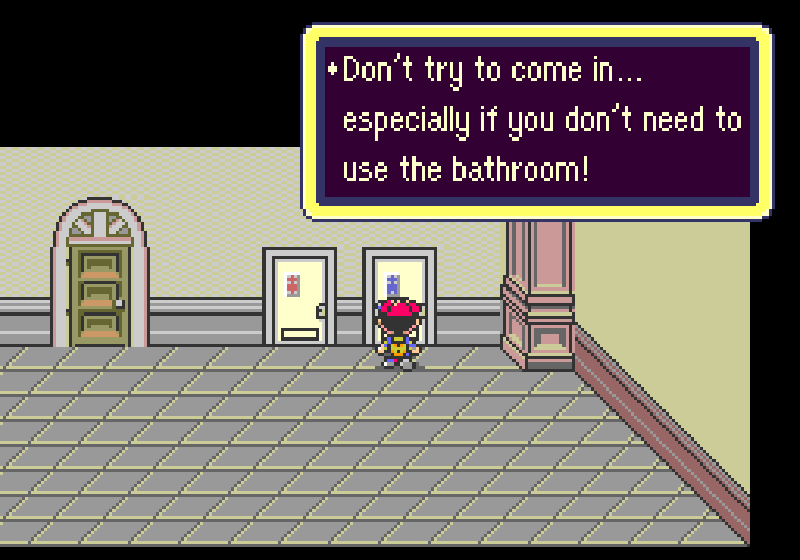
2. Earthbound (Super Nintendo via Wii U Virtual Console, 1995)
Despite taking me eight months to finish (this is why those 5-10 hour games are capturing my attention much more often than lengthy RPGs, these days), and despite its age, Earthbound did some things I wasn’t expecting and, frankly, have never seen before in a video game. With regards to gameplay, it is a standard RPG of its time, complete with clunky inventory management and other annoying limitations of its era. Everything else, however, is golden.
I was moved by the story in a way a video game story hasn’t affected me in a long time. Here’s the thing about Earthbound: it’s up to the kids to save the world because the adults are too wrapped up in their own problems. Yes, Ness technically falls into a “chosen one” sort of trope, so it is ultimately up to him, anyway, but aside from a handful of especially involved adults, the rest are either driven to aggressive behavior by Giygas’s influence, or too distracted by work or other responsibilities to even realize that Earth is in peril. Ness’s dad is gone on business through the whole game, and can only save your game and make bank deposits for you via phone calls. Calling Ness’s mom can relieve your homesickness, but otherwise, she’s taking care of the dog or watching soap operas. It’s like that with most of the adults.
This trend rekindled memories of me as a kid, in my own world dealing with my own problems, both real and imaginary, completely apart from my parents and other adults. How many troubling encounters did I have at school with other kids or fitness tests or teachers having bad days that I never told any adults about? How many times did I go on adventures outside, fighting imaginary adversaries with imaginary consequences? How many times were there health problems or money problems or so on going on that I was too young to understand or too timid to ask for more information about, but still internalized and worried over?
Yeah, none of those kid problems were as big as saving the world, but I felt like Ness and his crew were so relatable as I played through their adventure. Not only do they have to save the world, but they have to do is as kids, with innocence and limited knowledge of the world around them and on top of the other challenges they already have to face. That’s what made Earthbound such a compelling experience.
Earthbound does a lot of other things right, too. Leveling up enough in each area allows you to automatically win random encounters against much weaker foes. This is a fabulous innovation that I haven’t seen in many, if any, other RPGs, and I don’t know why. Rather than insulting your skill and making you fight battles you’re not going to lose, Earthbound doesn’t waste your time. It assumes your party will smear weaker enemies and doesn’t even bother making you fight them. There are great applications of contemporary real-life items (bottle rockets and frying pans as weapons, protein drinks and Cup of Noodles as recovery items) that fit the mood and setting of the game, and lots of creative dialogue and humor. Plus, there’s an amazing cast of characters like Dungeon Man (a man who is…well, also a dungeon you have to fight through), bizarre enemies like Ramblin’ Evil Mushrooms, hippies, scalding cups of coffee, Master Belch (a literal pile of puke), and a bonkers final boss that has to be experienced firsthand.
It’s a completely ridiculous game, but poignant and heartfelt, too.
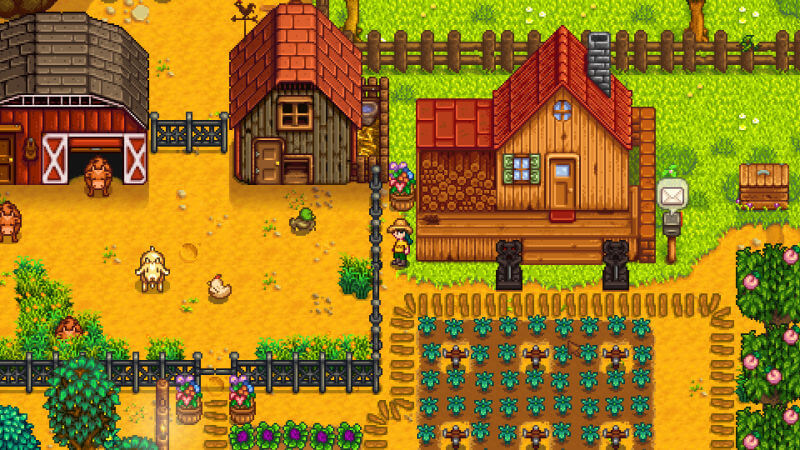
1. Stardew Valley (Switch, 2016)
I was really tempted to list Earthbound as my number one game, but I just couldn’t. Despite the emotional impact of Earthbound, no game sunk its pixelated teeth into me in 2018 quite like Stardew Valley. I don’t think I’ve played it since January of this year, and according to the monthly newsletter I get from Nintendo, it’s still listed as the game I’ve played the most in 2019, so I’m really shocked by just how many hours Stardew Valley drained away from my personal time that should have been spent writing blogs, probably.
Still, I must admit that I don’t feel too bad about it. During an otherwise stressful end to 2018, Stardew Valley provided a soothing experience at the end of each day. It was nice to play a game in which I didn’t have to save anybody or anything, or fight some terrible evil, or worry about inventory management or leveling up the right stats. All I really had to do was water my plants every day. Beyond that, I could farm, fish, mine, hang out with the townsfolk, and attempt to unravel the mysteries of the valley. Thus far, my play of Stardew Valley might as well be Every Hallmark Channel Movie: The Game. This is how it has gone:
- Main character moves away from big city hustle and bustle
- Takes over grandfather’s dilapidated farm near a small town and slowly restores it to its former glory
- Gets to know the townsfolk and settles minor disputes between them
- Does good deeds, starts fixing up the old community center
- Is helpful to young people, the elderly, and local business
- Gradually gains the acceptance of the townsfolk and cutely and innocently woos one of the womenfolk, despite some boneheaded misunderstandings along the way (like accidentally gifting her a piece of trash I caught in one of my crab traps)
- There’s magic. Possibly Christmas magic.
I mean, I know some people who would watch that movie.
Anyway, the farming is fun on its own, but the RPG elements and the aforementioned mysteries surrounding the valley push the game into “one of my favorites in recent years” territory. It took me a season or two to develop a routine and arrange my farm and crops to be efficient, but once I had it figured out, I started reaping the benefits and was poised and ready to put the local Walmart out of business. 60 hours later, I…well, I’ve gotten a lot done, and I have a very pretty farm, but I know there is still a ton of content I haven’t touched. I just have to resist the urge to start a new game when I start playing again….
Thanks for reading! I hope it won’t take me five months to put together the inevitable Top 10 Video Games of “2019” post. Until next time!
[Image Credits: MobyGames]